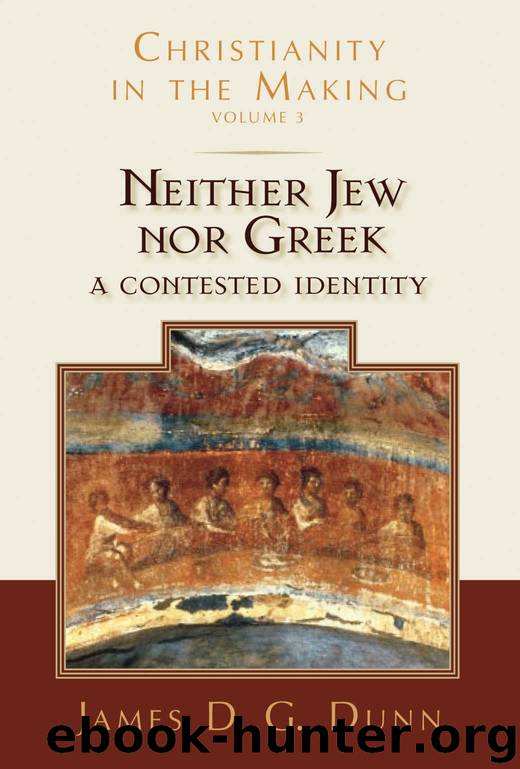Neither Jew nor Greek: A Contested Identity (Christianity in the Making, Volume 3) by James D. G. Dunn

Author:James D. G. Dunn [Dunn, James D. G.]
Language: ara
Format: azw3
Publisher: Wm. B. Eerdmans Publishing Co.
Published: 2015-11-08T16:00:00+00:00
44.7 Narrative Gospels
There are also Gospels or closely related writings which develop the narrative tradition of the first-century New Testament Gospels. They are almost all novelistic, speculative and often fantastical elaborations of parts of the Gospel accounts which were too brief or left many questions unanswered.
a. Gospel of Peter
The most striking is the Gospel of Peter, which seems to be an elaboration of early traditions of the crucifixion, burial and resurrection of Jesus.299 There has been a notable attempt to find embedded in the Gospel of Peter an early, indeed the original, passion narrative.300 But dependence of the Gospel of Peter on the NT Gospels, perhaps only through second orality, is clearly to be seen — for example, Pilate’s washing his hands at Jesus’ trial and the guard set on Jesus’ tomb from Matthew (Gosp.Pet. 1.1/Matt. 27.24; Gosp.Pet. 8.29–11.49/Matt. 27.62-66; 28.11-15),301 and the repentant thief from Luke (Gosp.Pet. 4.13/Luke 23.40-41).302 The variations from the NT Gospel tradition are partly to be explained in terms of the variations within the Jesus tradition on Jesus’ passion: greater awareness of the phenomenology of oral tradition has made clear that variation in tradition is to be explained more likely by social variables affecting different performances than by literary-type redaction;303 the NT Gospels themselves provide clear testimony that there was no single (written) version of Jesus’ passion from which the different passion narratives were derived.304 But no doubt the Gospel of Peter’s version is also to be explained by the curiosity which, for example, Matthew’s story of the guard presumably provoked, and particularly by curiosity about the resurrection of Jesus itself. The fact that Jesus’ resurrection is not described in the earlier Gospels would have provided sufficient incentive for an imaginative attempt to provide such an account.305 Hence the striking and rather fantastical account of the stone rolling away ‘of itself’ from the mouth of the tomb, of ‘two men’ coming down from heaven and entering the tomb, and of the watching guard seeing ‘three men come out from the sepulcher, two of them supporting the other and a cross following them, and the heads of the two reaching to heaven, but that of him who was being led reached beyond the heavens’ (Gosp.Pet. 9.36–10.40).
There may be a docetic tinge in the document, as Serapion concluded: it is suggested that Jesus felt no pain on the cross (4.10); and Jesus cries out from the cross, ‘My power, O power, you have forsaken me’ (5.20). But even so, Peter can hardly be called a Gnostic Gospel.306 Moreover, it implies that the Jews were responsible for the crucifixion itself (6.21) and attempts to exonerate Pilate (11.46), strengthening a tendency already evident in the NT Gospels, but probably also reflecting the increasing hostility towards Jews in second-century Christianity.307 In any case, there is no real evidence in the Gospel of Peter of an account of Jesus’ passion earlier than and independent of the NT Gospels and of the traditions which they embody; and there is sufficient evidence of Peter’s dependence on distinctive features of the NT Gospels.
Download
This site does not store any files on its server. We only index and link to content provided by other sites. Please contact the content providers to delete copyright contents if any and email us, we'll remove relevant links or contents immediately.
The Gnostic Gospels by Pagels Elaine(2473)
Jesus by Paul Johnson(2313)
Devil, The by Almond Philip C(2284)
The Nativity by Geza Vermes(2181)
The Psychedelic Gospels: The Secret History of Hallucinogens in Christianity by Jerry B. Brown(2122)
Forensics by Val McDermid(2049)
Going Clear: Scientology, Hollywood, and the Prison of Belief by Lawrence Wright(1940)
Going Clear by Lawrence Wright(1927)
Barking to the Choir by Gregory Boyle(1786)
Old Testament History by John H. Sailhamer(1770)
Augustine: Conversions to Confessions by Robin Lane Fox(1737)
The Early Centuries - Byzantium 01 by John Julius Norwich(1702)
A History of the Franks by Gregory of Tours(1688)
A Prophet with Honor by William C. Martin(1685)
Dark Mysteries of the Vatican by H. Paul Jeffers(1678)
The Bible Doesn't Say That by Dr. Joel M. Hoffman(1652)
by Christianity & Islam(1596)
The First Crusade by Thomas Asbridge(1576)
The Amish by Steven M. Nolt(1534)
